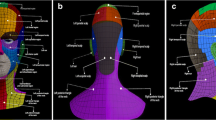Abstract
Background: If cutaneous lymphoscintigraphy (CL) is accurate in predicting the draining lymph node basins at risk from primary axial melanomas, then regional metastases should only occur in those lymph node basins identified by CL.
Methods: This study is a retrospective review of patients undergoing CL for primary axial melanomas from June 1, 1985, until June 31, 1992. Data retrieved included age, gender, number of basins identified, location of basins identified, management of basins, recurrence in lymphatics, development of distant disease, and long-term follow-up.
Results: A total of 181 patients underwent elective LND, and 48 patients (27%) had melanoma in the nodes within the dissected basin. Of these 181 patients, seven developed nodal metastases as their site of first recurrence. All seven recurrences were seen at sites dissected or at sites indicated by CL, which the primary surgeon elected not to treat initially. Of the 116 patients observed, 16 (14%) developed lymph node metastases as their first site of recurrence. Fifteen of these 16 patients had their site of lymph node metastases predicted by CL. In this study, CL predicted 98.6% of all lymph node metastases.
Conclusions: The high overall reliability of CL as demonstrated by long-term follow-up indicates that the information obtained by CL can be reliably used to guide intervention. Initial evaluation of patients with high-risk cutaneous melanomas at sites with ambiguous lymphatic drainage must include CL in order to determine the draining lymph node basins and to plan therapy.
Similar content being viewed by others
References
Balch CM. The role of elective lymph node dissection in melanoma: rationale, results controversies.J Clin Oncol 1988;6:163–72.
Balch CM, Milton GW, Cascinelli N, Sim FH. Elective lymph node dissection: pros and cons. In: Balch CM, Houghton AN, Milton GW, Sober AJ, Soong S-j, eds.Cutaneous melanoma. 2nd ed. Philadelphia: JB Lippincott, 1992;345–66.
Morton DL, Wen DR, Wong JH, et al. Technical details of intraoperative lymphatic mapping for early stage melanoma.Arch Surg 1992;127:392–9.
Ross MI, Reintgen D, Balch CM. Selective lymphadenectomy: emerging role for lymphatic mapping and setinel node biopsy in the management of early stage melanoma.Semin Surg Oncol 1993;9:219–23.
Ross MI. The case for elective lymphadenectomy.Surg Oncol Clin North Am 1992;1:205–22.
Sappey MPC.Anatomie, physicologie, pathologie, des vaiseaux lymphatiques consideres chez l'homme et les vertebres. Paris: A De Lahaye and E Lecrosnier, 1874.
Sugarbaker EV, McBride CM. Melanoma of the trunk: the results of surgical excision and anatomic guidelines for predicting nodal metastasis.Surgery 1976;80:22–30.
Meyer CM, Lecklitner ML, Logic JR, Balch CM, Bessey PQ, Tauxe WN. Technetium-99m sulfur-colloid cutaneous lymphoscintigraphy in the management of Truncal melanoma.Radiology 1979;131:205–9.
Lock-Andersen J, Rossing N, Drzewiecki KT. Preoperative cutaneous lymphoscintigraphy in malignant melanoma.Cancer 1989;63:77–82.
Norman J Jr, Cruse W, Ruas E, et al. The expanding role of lymphoscintigraphy in the management of cutaneous melanoma.Am Surgeon 1989;55:689–94.
Norman J, Cruse CW, Espinosa C, et al. Redefinition of cutaneous lymphatic drainage with the use of lymphoscintigraphy for malignant melanoma.Am J Surg 1991;162:432–7.
Norman J, Wells K, Kearney R, Cruse CW, Berman C, Reintgen D. Identification of lymphatic drainage in patients with cutaneous melanoma.Semin Surg Oncol 1993;9:224–7.
Balch CM. Surgical management of regional lymph nodes in patients with cutaneous melanoma.J Am Acad Dermatol 1980;3:511–24.
Uren RF Howman-Giles RB, Shaw HM, Thompson JF, McCarthy WH. Lymphoscintigraphy in high-risk melanoma of the trunk: predicting draining node groups, defining lymphatic channels and locating the sentinel node.J Nucl Med 1993;34:1435–40.
Balch CM, Soong S-J, Shaw HM, Urist MM, McCarthy WH. An analysis of prognostic factors in 8500 patients with cutaneous melanoma. In: Balch CM, Houghton AN, Milton GW, Sober AJ, Soong S-J, eds.Cutaneous melanoma. 2nd ed. Philadelphia: JB Lippincott, 1992:165–87.
Author information
Authors and Affiliations
Rights and permissions
About this article
Cite this article
Berger, D.H., Feig, B.W., Podoloff, D. et al. Lymphoscintigraphy as a predictor of lymphatic drainage from cutaneous melanoma. Annals of Surgical Oncology 4, 247–251 (1997). https://doi.org/10.1007/BF02306617
Received:
Accepted:
Issue Date:
DOI: https://doi.org/10.1007/BF02306617




